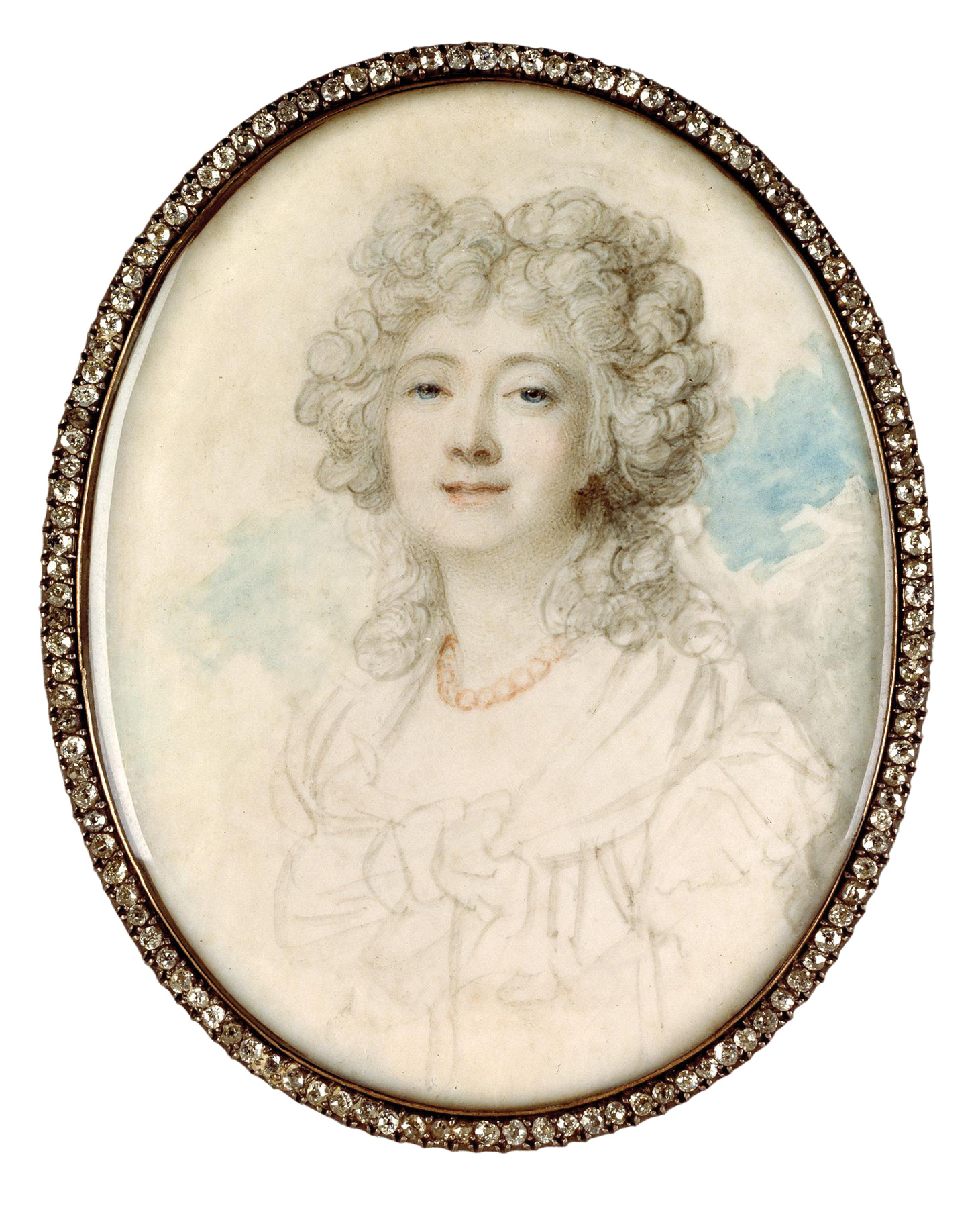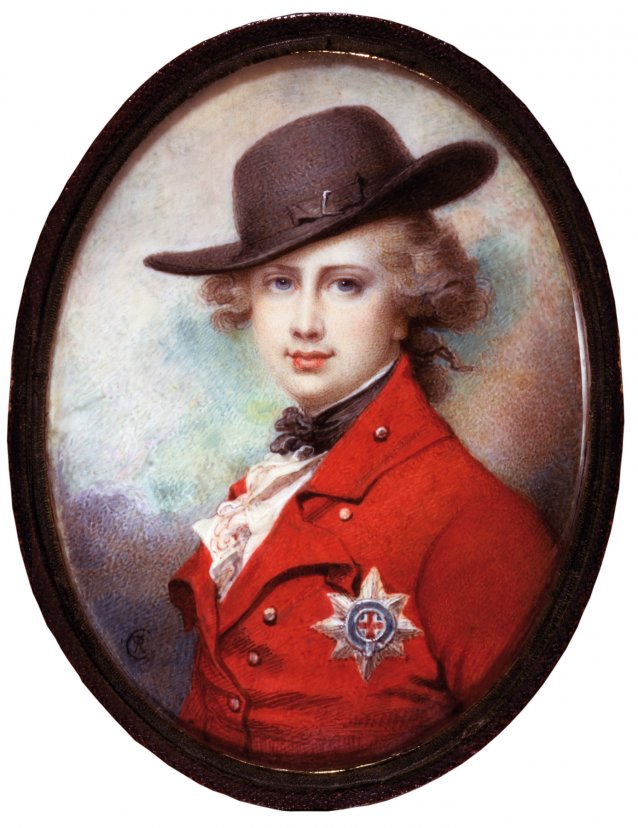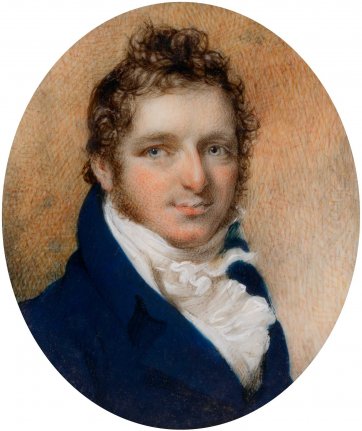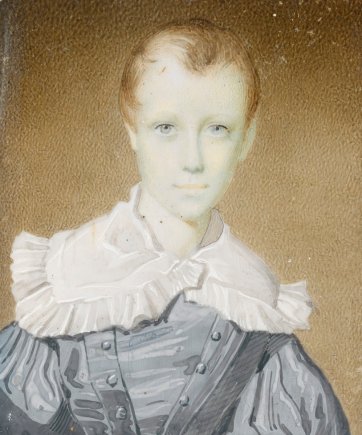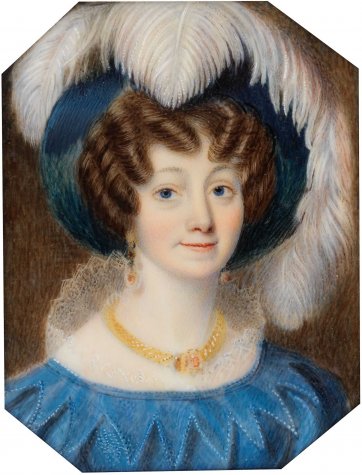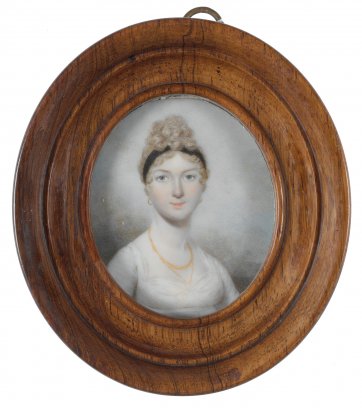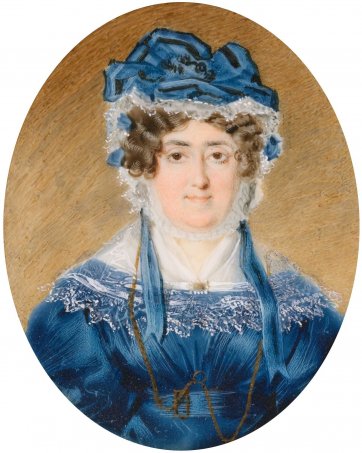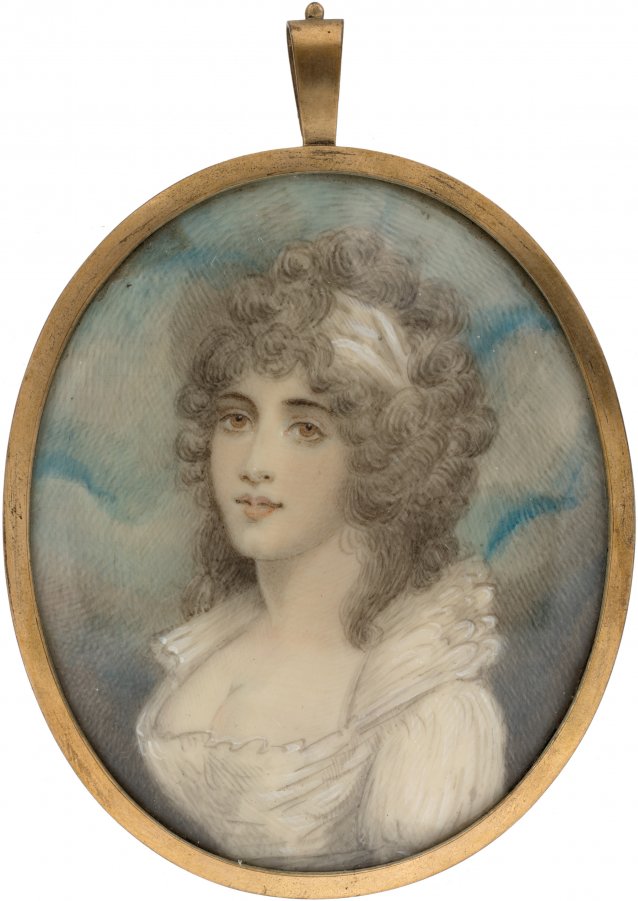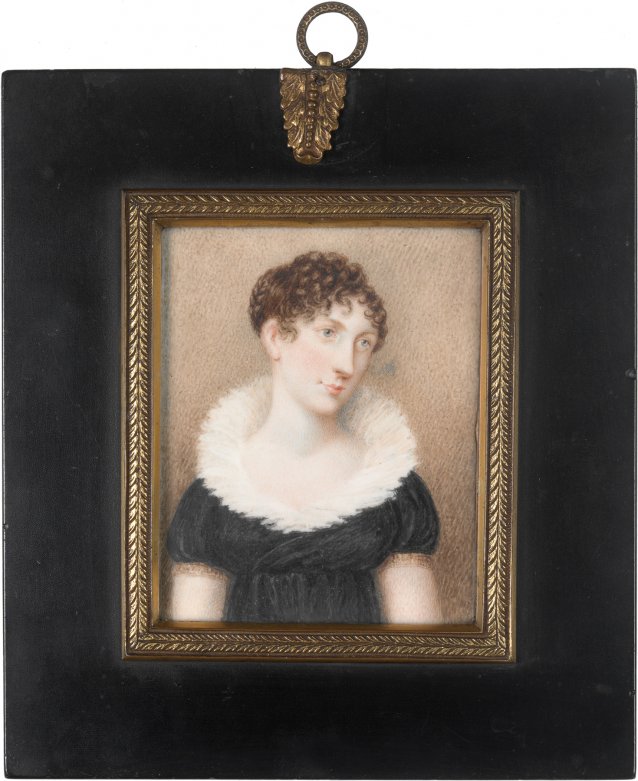Before the 1840s, when photography started to reconfigure the practice and application of portraiture, miniatures were among the relatively few means by which people might secure tangible and enduring mementos of their loved ones. Typically executed in watercolour on panels of ivory and contained in petite frames, or mounted in pendants, brooches, rings, snuff boxes and lockets, portrait miniatures were presented so that they could be clutched, kissed, concealed, carried in a pocket close to the heart, or stashed inside a trunk or reticule. Locks of the sitter’s hair, coiled in behind the portrait, gave many miniatures a talismanic touch. The likenesses they captured, more often than not, were of people who were much-loved, much-mourned, much-missed or much-fancied by those who had acquired and commissioned them. Men and women, young or old, were often rendered as rosy-cheeked, plump-lipped and doe-eyed in portraits which were engineered to induce fondness and longing. ‘Whereas easel portraits present a public self meant to face outward, portrait miniatures reveal a private self meant to face inward’, explains the American writer and curator Robin Jaffee Frank. Unlike their larger cousins, she continues, they thereby ‘invite inquiry into the particular bonds between sitter and beholder’.
Little women
by Joanna Gilmour, 5 August 2019
Originating as illustrations for handwritten books and illuminated manuscripts, portrait miniatures came into use among royalty and the nobility during the sixteenth and seventeenth centuries for purposes such as the transacting of engagements and marriages, the displaying of political allegiances, and as expressions of one’s amours and attachments. By the second half of the eighteenth century, miniature painting had become something of a profession, with the emerging mercantile and aspirational classes providing a market for these delicate, private tokens of friendship, kinship and affection. Miniaturists began exhibiting their works in the Royal Academy’s annual shows soon after the Academy’s inception in 1768, and artists such as Richard Cosway (1742–1821), painter to the Prince of Wales (later George IV), were not only successful and prolific portraitists but highly fashionable ones too. Cosway, who developed a distinctive style in which the tiny stippled details of faces were contrasted with the expressive brushstrokes by which he delineated upper bodies and cloudy backgrounds, was known for making his sitters look alluring and elegant, or – as in the case of his epically dissipated royal patron – charming and respectable. His sitters included eighteenth-century fashionistas like Georgiana, Duchess of Devonshire; national heroes like the Duke of Wellington; and celebrities, including the courtesan Jeanne Bécu, aka Madame du Barry, who became Louis XV’s ‘official’ mistress in the 1760s. During the same period, artists including John Smart (c. 1742–1811) and Ozias Humphry (1742–1810) sought permission from the East India Company to work in Chennai, Mumbai and other outposts, creating portraits for expats and officials to send home.
Miniatures were therefore a well-established form of sentimental currency when Britain, in 1786, decided to expand its empire to encompass much of the continent known as New Holland, the eastern seaboard of which James Cook had charted sixteen years previously, and which had been successfully pitched to the government by Cook’s shipmate, Joseph Banks, as an appropriate site for a colony. It might thus be argued that miniatures with early Australian associations have a particularly potent aura or poignancy, being portraits that encapsulate closeness and intimacy at the same time as they suggest absence, and separation across vast, unfathomable distances. You can’t help but feel, for example, for Lieutenant Ralph Clark, who – apart from his infamous opinion that female convicts were all ‘damned whores’ and ‘ten thousand times worse than the men convicts’ – is primarily remembered for the journal in which he chronicled his tour of duty to New South Wales from 1787 to 1792. The first part of it includes his observations of the journey to Sydney on the Friendship, one of the convict transports among the eleven ships that formed the First Fleet. As abstemious and sanctimonious as he evidently was, the depth of Clark’s sadness at being separated from his wife Betsey Alicia and son is palpable. ‘To Botany Bay I must go’, Clark sighed before the Fleet had even lost sight of England; ‘I trust in God that it is all for the best [for] if I thought otherwise I never should have thought of leaving the best of women and the most sweetest of boys.’ Most days he wrote of missing them, dreaming of them, fearing for their wellbeing and praying to the almighty to protect and/or bless them, and in addition made numerous references to his interactions with a miniature of his wife ‘which we had done by a limner’ prior to his departure. On Sundays, he’d remove the portrait of his ‘Beloved woman the most tenderest of wives’ from the bag in which it was kept and kiss it. ‘Read the Service for the day and the Psalms and kissed my beautiful Alicia’s Picture out of its little bag this morning ten thousand times’, notes the entry for 23 October 1787, for example. On 4 November it was: ‘This being Sunday took my beloved Alicia picture out of its prison and kissed it I believe a thousand times.’
Given this proof of the hold that miniatures might have on the imagination, it is easy to assume that the colonisation of Australia generated work for many a limner, whether the English ones producing keepsakes of and for people who’d be enduring lengthy and possibly even permanent separations, or the locally available practitioners who answered the demand for miniatures here. Australian collections are amply peppered with both types. These are portraits that are impressive not merely for the detail and finesse achieved by their makers at such a diminutive scale, but for their durability across thousands of miles of potentially perilous trans-global travel and exchange. The National Portrait Gallery’s collection, for example, includes the Regency-era miniatures of lawyer and free settler Gamaliel Butler, who left his six children in the care of relatives in England when he and his wife voyaged to Van Diemen’s Land in 1824; and of Richard Windeyer, who remained in London to finish his legal training when the rest of his family left for New South Wales in 1828. Both are embellished with perfectly preserved curls of their subjects’ hair.
Then there are works such as the miniature of Windeyer’s only son, William Charles, at age six. ‘I am going to send my dear Father a little packet containing Willy’s picture’, wrote his mother Maria to her sister in England in November 1840. ‘We think it very like him particularly the upper part of the face and head but the difficulty of getting him to sit still made the mouth less like his it does not convey to you the loveliness of his general look & is done on ivory and will therefore I hope keep well.’ Another is the beautifully realised likeness of Fanny Jane Marlay, the daughter of a British military officer who came to Sydney in the 1820s. Fanny’s portrait, in which she is shown wearing an elaborate feathered hat and a gown topped with an intricate (and finely executed) lace collar, possibly dates from around 1841, the year in which she married navigator and hydrographer John Lort Stokes in Sydney, and also the year in which Stokes was promoted to the command of the survey ship Beagle. Stokes embarked on another surveying voyage two months after his marriage and is known to have taken a portrait of Fanny with him, as one observer reported seeing it in his cabin when the Beagle called at Hobart in 1842. Fanny died in South Africa while making a return journey with Stokes to Sydney in July 1848; the miniature of her remained in Stokes’ possession until his own death in England almost 40 years later.
And there are miniatures of the various other women who accompanied male relatives on postings to the geographical extremities of empire and back again, multiple times in some cases. William Bligh’s daughter Mary travelled with her father and her first husband John Putland (Bligh’s aide-de-camp) to Sydney, when Bligh became governor of New South Wales in 1806. Before leaving England, she sat for an unidentified miniaturist who, as was the fashion, portrayed her with coral-pink lips, a porcelain-like pallor and wearing a high-waisted white muslin gown. Elizabeth Macquarie, the wife of Bligh’s successor Lachlan Macquarie, appears similarly sweet in a miniature gifted to Macquarie’s friend and aide John Cliffe Watts on the latter’s departure from Sydney in 1819. And Anna Josepha King seems suitably affectionate and motherly in a miniature – recently acquired by the Portrait Gallery – that is thought to have originally been made as a keepsake for her youngest daughter, Mary, who married in London in 1826 and left for Sydney the following year. Anna (1765–1844) first came to New South Wales in 1791 when her husband Philip Gidley King took up the role of lieutenant-governor of the settlement on Norfolk Island, and would traverse the globe again in 1799 after he was appointed governor of New South Wales. Once again, Anna’s portrait is a marvel for the minute brushstrokes with which individual eyelashes and ringlets are rendered, the tiny dabs of white delineating the glint in her eyes and the seed pearls on her brooch, and the deft, delicate lines and areas of shadow suggesting the sheen of her blue silk dress. On the whole, they are portraits that conform to the idea that the women who functioned as arbiters on matters pertaining to duty, fashion, or morality were themselves as uncomplicated as their portraits suggest – their bearings demure, their constitutions delicate, their tempers smooth and inoffensive. As Anna King’s biographer, writing in 1940, said of prominent colonial women, even ‘when we have read all we can in the printed records of the adventures of those days, adventures in which they shared, they still remain elusive shadows behind the solid form of their husbands’. More recently, however, by way of inventive re-examinations of sources, including artworks, it has been possible to draw a much more rounded picture of women’s lives and relationships, and of what historian Tanya Evans has described as the ‘multi-layered, interlocking and enormously complicated picture of family life in early colonial Australia’.
Consider as an example the domestic arrangements that greeted the newly-wed Anna King on her introduction to Norfolk Island in 1791: rather than the unblemished scenario one might expect of the settlement’s first family, Anna was presented with one wherein she became responsible for the two sons resulting from King’s former relationship with his convict housekeeper, Ann Inett. Convicted of housebreaking, Ann had been transported to Sydney on the First Fleet and was among the first convicts sent to the settlement King established on Norfolk Island in 1788. Such situations, however, were not uncommon. Even Ralph Clark, for all of his weeping and pining over his wife’s portrait, and his outward distaste for the uninhibited inclinations of his colleagues, eventually saw fit to avail himself of a convict companion, Mary Branham, who gave birth to Clark’s daughter in July 1791. (The child was later baptised Alicia – after Clark’s ‘best-of-women’ wife at home in England.) There is nothing in Mary Putland’s portrait to indicate a woman amply possessed of her father’s legendary ‘firmness & Integrity’, who is said to have vigorously abused the hundreds of well-soused soldiers who effected Bligh’s overthrow in January 1808, and who maintained enmities against his detractors for years thereafter. Nor does a miniature of a pale and buxom lady purported to be Elizabeth Macarthur hint at the astute, indomitable woman who proved most adept at managing the family’s business enterprises while her husband was in England answering for himself in respect of certain transgressions (the aforementioned ousting of Bligh, for instance). Writing to Elizabeth in 1810 of the ‘difficulties’ occasioned by his absences, John Macarthur declared that ‘not one woman in a thousand (not one that I know) would have the resolution and perseverance to contend with them at all, much more to surmount them in the manner you have so happily done’. Elizabeth’s own writing reveals a woman of great wit, grit and intellect and, intriguingly, proves the nature and extent of the cross-cultural transactions that she and contemporaries like Anna King took in their stride. ‘The natives visit us every day, more or less’, Elizabeth wrote in 1791. ‘Men, Women, and children, they come with great confidence, without spears or any other offensive weapons.’ On one occasion, the Eora woman Daringa (or ‘Mrs Coleby’ as Elizabeth called her), ‘brought in a new born female infant of hers for me to see. It was wrapped up in the soft bark of a tree, a specimen of which I have preserved; it is a kind of mantle not known in England I fancy.’
Likewise, in her shipboard diary of 1809, Elizabeth Macquarie matter-of-factly wrote of being able to ‘plainly perceive the smoke of the natives fires’ as she sailed along the New South Wales coast, and was unflinching in recording facts such as the Portuguese slave ship she encountered in South America, or the seaman who fell ‘from the fore top mast rigging on the forecastle and fractured his skull, which occasioned his immediate death’. Despite having never undertaken a sea voyage before, let alone one of such magnitude, she was able to report six months into the trip that ‘on coming on board I always feel now as going home, the Ship appearing to me in the place of a house which had long been my habitation’.
The journal Anna King kept on her second journey from England to Sydney in 1799 displays a similar degree of stomach and open-mindedness. On the day the perhaps wishfully-named Speedy left Spithead, Anna wrote ‘none of my family sea sick nor have we time to think of it’. It’s as if you can hear her thinking to herself ‘touch wood’ as she wrote it. A day later, though, Philip was ‘seized with a violent cold and rheumatism’, and for the remainder of the voyage was regularly laid low ‘with gout in every part’. Apart from her worries about him and her children, if anything perturbed Anna it was usually foul weather or the occasional sighting of ‘strange sail’. She appears to have thought nothing of writing of unseemly matters, including the ship’s doctor being ‘quite out of his mind’ (‘to me he looks mad and acts mad’); a convict, Mary Butler, who died en route having given ‘every appearance of madness’; another who threw herself overboard rather than submit to being ‘pumped’ (a punishment involving bilge water, perhaps?); the ‘appearance amongst the ladies’ of a venereal condition which she termed ‘Scotch fiddle’; or the indignities endured by sailors who were ‘crossing the line’ (i.e. the equator) for the first time.
‘I hope never to take another voyage after arriving again in England, for I am quite sick of the seas’, Anna wrote on landing in Sydney in April 1800. She made the journey again, regardless, in 1832; widowed 24 years previously, she returned to Sydney to be near those of her children who’d opted for the colony’s greater prospects for prosperity. ‘She is very active and visits about in a most wonderful way for an elderly person’ wrote Elizabeth Macarthur of her friend in 1832, in a further proof that the delicate portrait miniature of Anna King in her supposed dotage belies the substantial private self of its subject. Just as Tanya Evans has written of the way in which the discoveries made by family historians have the capacity to ‘disrupt many of our assumptions of the past’, the retelling or recasting of the stories embedded in the portraits of Anna and her contemporaries reveal them to have been inwardly possessed of as much gumption as their menfolk, no matter how convincingly they or a portraitist might present an outside that was the quintessence of passivity and refinement. In a surreptitious way, these miniatures instead present the satisfying inverse possibility that they were cherished by their original beholders as mementos of women formed of sterner, enduring and indeed unconventional stuff.
Related information
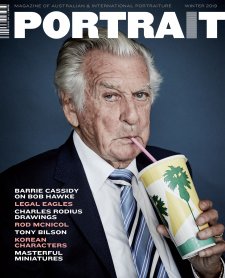


Portrait 63, Winter 2019
Magazine
Rod McNicol's method and motivation, 19th century Indigenous peoples, Barrie Cassidy on Bob Hawke, five generations of the Kang family from Korea and more.



The intellectual larrikin
Magazine article by Barrie Cassidy
Barrie Cassidy pays textured tribute to the inimitable Bob Hawke.
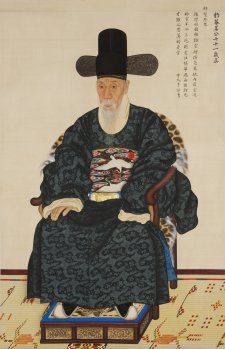
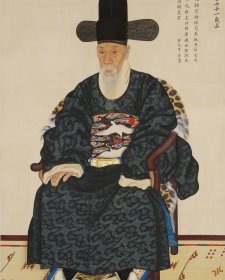
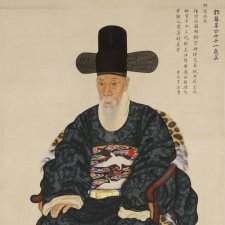
The artist, the scholar and the gentleman
Magazine article by Kwon Hyeeun
Kwon Hyeeun introduces Korean portraits of Kang Sehwang, and five generations of the Kang family.
